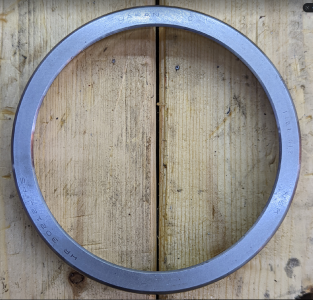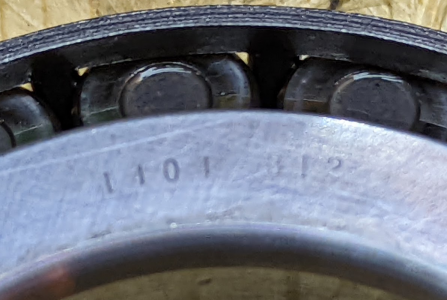We probably got the same ratcheting c clip wrench set, even if it has a different brand name on it... Mine was HILTEX. I'll probably replace those terrible philips screws with hex heads at some point, at least if I use this much more.
I didn't notice the black interior circumferential circles on the outboard outer race when I was disassembling it. I'm guessing that google decided to "enhance" the picture and make it look more clearly focused, but in any case, that's where the ends of the rollers were running. I looked again at the cleaned bearing and there's some wear in the areas of those lines (though more distributed than you would guess from the picture) so I think that might have been the edges of the rollers grinding up grit! In case I had any doubts about whether I should be replacing them...
Tonight I removed the cage and inner race from the spindle. I removed the keys from the spindle, then I heated the race with a heat gun until the residual oil on it got hot enough to smell. Then I turned the spindle nose-up on some pieces of wood and gently tapped the race with the loose nose bearing retainer. I re-heated the race once or twice, and it took probably a couple of minutes of light tapping before the race neatly dropped onto the supporting pieces of wood (while I kept my grip on the bearing retainer to not drop it as well). To be clear, I wasn't hammering on the bearing retainer; I held it with my fingers on opposite sides, and used it as a very very gentle captive slap hammer, moving it around the bearing as I went to make sure it was getting even pressure so it wouldn't rack.
Yeah, the spindle side bearing is marked P5, and it's definitely etched not stamped. But I don't see an eccentric mark. Here it is with the oil wiped off:

Is the "1404 312" is a serial number? It matches the other half, but I don't have anything to compare it to. Sorry, was having trouble with macro focus but it's almost legible here:

Given the lack of eccentric marks (that I can see), does it seem legit that these are P5?
All the ball bearings are turning freely, and they spin freely when I let them go. No bad noises. I think that ball bearings are far more able to reject chips around the side than roller bearings, so that's not a huge surprise. For better or worse, not going to invest on replacing them all right now. I could easily imagine making another decision if I were putting in better bearings.
While I already have some magnets, I'm going to buy more, and clean out the sump with WD40 before I put anything back in.
Re-install after cleaning, something like this: (See comment #35 for what I actually did)
Cut new gaskets (I think; I bought new gasket material, but on the other hand it's not torn)Lightly oil spindle shaft, heat new chuck-end spindle bearing, install on spindle shaft. Replace clip ring.Re-install keys in spindle shaftLightly oil outer raceways, chill them in freezerHeat-soak new outboard spindle bearing; set asideLightly oil outer raceways; tap with wood to install front and back flush with caseWith wood on ways for support, re-install spindle, putting gears back on as it goes through the headstock case. Remember to include the speed shift block properly indexed, or I'll be very sad and have to start over later! Make sure all the clip rings are in place.Screw spindle side bearing retainer ring in place, seating the spindle bearing race to its intended depth.Re-heat new outboard spindle bearing, install on spindle shaft.Screw outboard bearing retainer ring in place, seating outboard outer bearing race to depth.Install the collar / spacer (also maybe it's a labyrinth seal?)Use the inner spanner nut to tighten just enough to remove play, not the additional torque for setting normal preload.Lock inner spanner nut with outer spanner nutRun clean oil through the taper bearing holes until it flows throughRefill the sump with clean oil, close the top.Run the full preload procedure, regularly checking temperature with an IR thermometer to make sure bearings aren't overheating, and listening carefully.Re-install spider
The manual has a preload procedure. In the version of the manual for my lathe ("Mfg. Since 5/11") it starts on page 67. Abbreviated:
- Run the lathe at high speed for 20 minutes
- Disconnect from power
- Remove chuck and spider bolts
- Loosen outer spanner nut two turns
- Loosen inner spanner nut one turn
- Hold wood block against outboard spindle end, tap lightly with a 3-4 lb hammer to introduce end play
- Dial indicator on cross slide, indicate against spindle face
- Move .1" closer to headstock and zero
- Tighten inner spanner nut until dial indicator needle just stops moving, rocking spindle back and forth. If you move further, to back to step 5 and unload.
- Tighten the inner spanner nut an additional 1/16 turn
- Without allowing the inner spanner nut to tighten further, tighten the outer spanner nut against the inner spanner nut. Not over-tight because that can add excess preload and damage bearing or even crack the headstock


